Red Velvet Cake or Cupcakes
Red Velvet Cake has been around at least since the 1920s but has enjoyed a renewed popularity over the last few years. This cake is soft and has a special flavor from buttermilk, cocoa and vinegar.
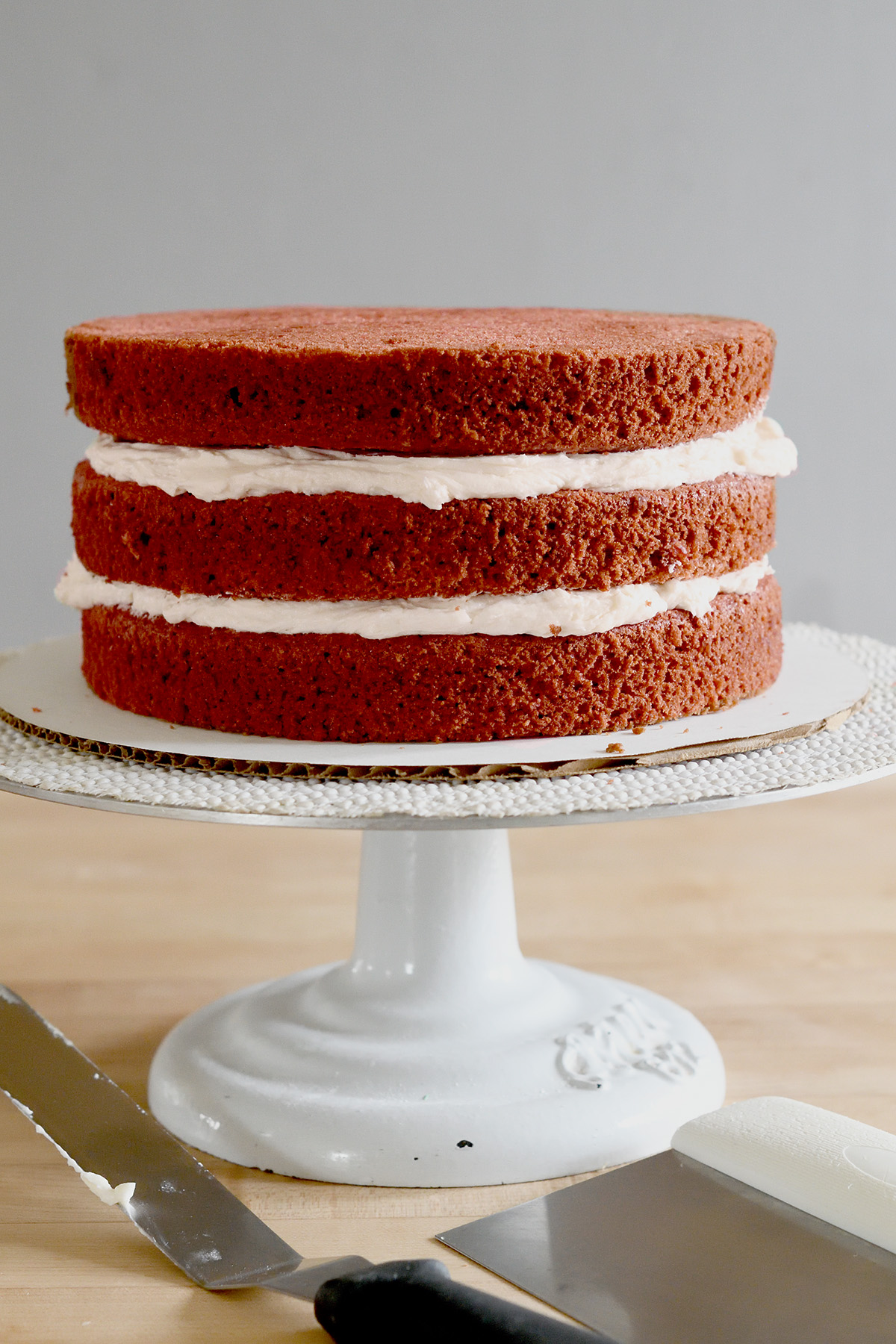
About Red Velvet Cake:
What makes a cake a Red Velvet Cake? Can you just add red food coloring to any cake recipe and call it “red velvet”.
Of course you can do that if you want to, but red velvet cake is not just a red-tinted cake. Red Velvet cake has wonderful and specific flavor and texture.
Traditionally, a red velvet cake recipe should include buttermilk, vinegar and cocoa. In the old recipes, a reaction between those ingredients and baking soda would create a light reddish brown color, hence the name of the cake.
I use a dutch-processed cocoa in my recipe. With less acid (from “dutching) the reaction is not quite the same as the old style cakes. I add food coloring to get the deep red color. Some folks use beets to tint the cake.
There are a million recipes to choose from, but I like the balance and texture of my recipe. It has just enough oil for moisture without the cake becoming gummy, and enough cocoa to give a slight chocolatey edge to the cake without turning it into a chocolate cake.
Ingredient Notes
- All Purpose Flour – I usually use low protein cake flour for my cake recipes. Because red velvet cake has a very high moisture content I use medium protein all purpose flour to enable the cake to maintain a stable crumb as it rises in the oven.
- Cocoa Powder – I prefer to use “dutch process” cocoa powder for it’s deep color and flavor. Dutching is a process to alkalize cocoa. This recipe will also work with “natural” cocoa.
- Baking Soda – Baking soda reacts with the acidic buttermilk and vinegar and creates carbon dioxide to leaven the cake.
- Buttermilk – The acidity in buttermilk contributes to the classic “red velvet” flavor.
- Vinegar – The acidic vinegar contributes to the classic “red velvet” flavor.
- Red Food Coloring – If you don’t like to use artificial color the red coloring can be left out with no effect on the flavor of the cake. I recommend gel color as you can get a much deeper color than with liquid color.
The Process
See the recipe card for detailed measurements and instructions.
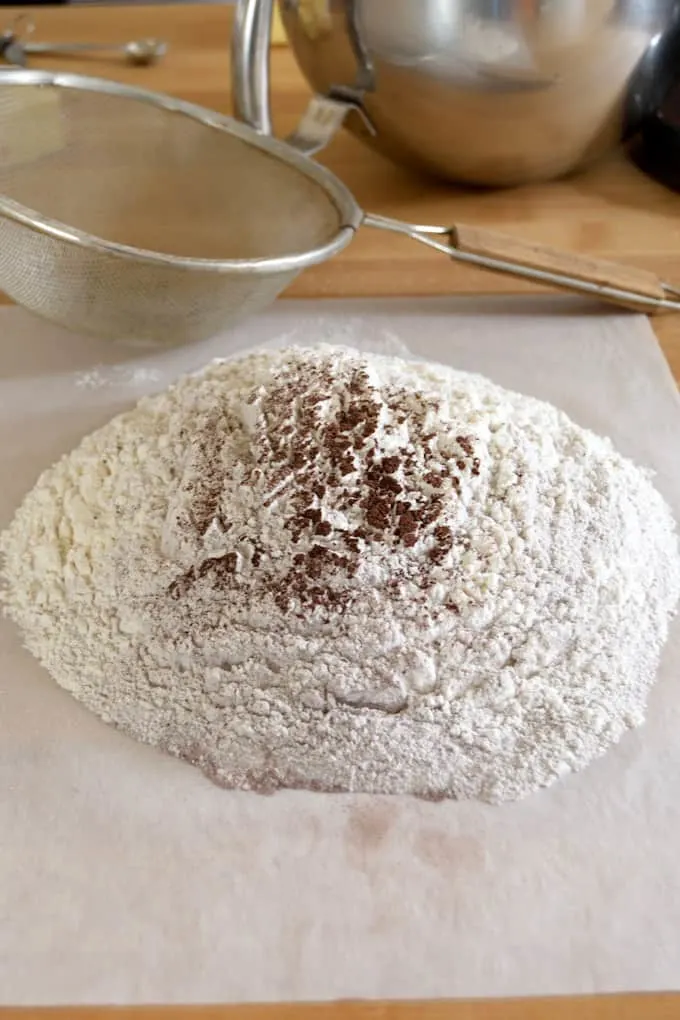
- Sift the dry ingredients onto a sheet of parchment paper. The paper makes it easy to add the ingredients to the batter.
- Combine the wet ingredients in a mixing bowl.
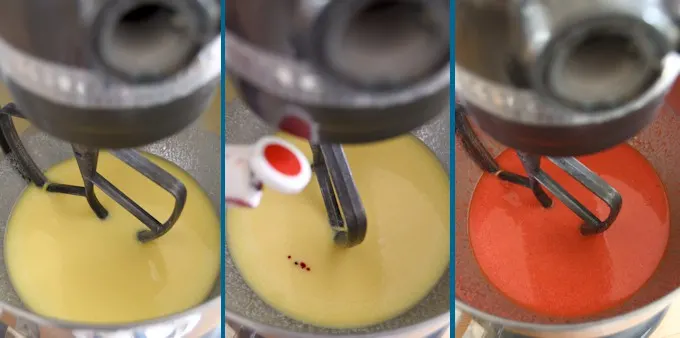
- Run the mixer for 1-2 minutes to emulsify the wet ingredients,
- Add the food coloring a few drops at a time.
- Add coloring to make the mixture slightly more red than you want the final cake to be. The color will mute when the dry ingredients are added.
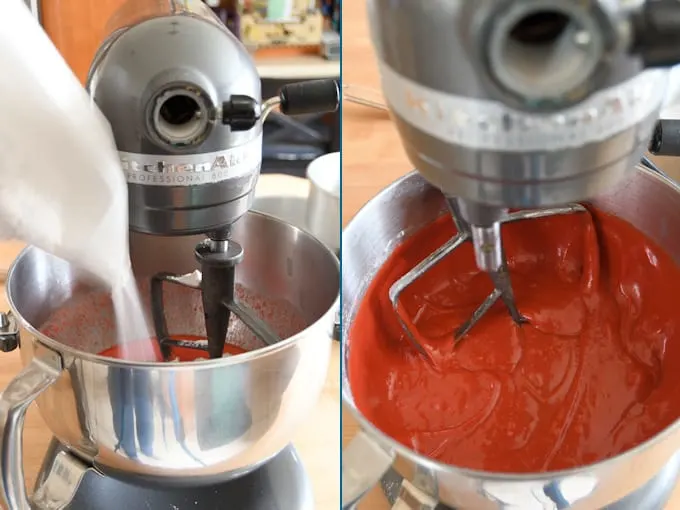
- Use the parchment to pour the dry ingredients into the batter.
- Mix just until combined.
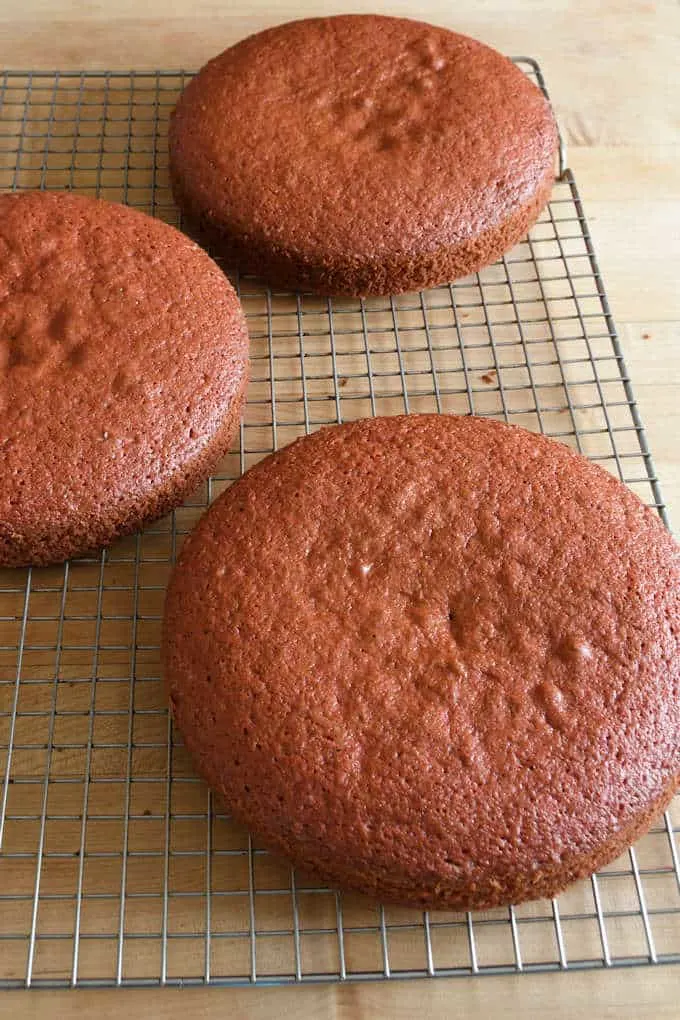
- Cool the layers completely before filling and frosting.
- I always trim off the top crust to level the layers and to help the frosting stick to the cake (plus the trimmings are a nice snack!).
- Fill and ice the cake with Cream Cheese Frosting or Ermine Frosting.
FAQs about Red Velvet Cake:
For this recipe it is the food coloring that makes the cake red. Some recipes use beets for a red color. The original recipes relied on a reaction between the vinegar and cocoa powder for a slight reddish color.
My favorite for Red Velvet Cake is Ermine Frosting. Cream Cheese Frosting is another traditional filling that is also delicious.
Yes. This recipe will make 24 standard size cupcakes, which take about 20 minutes to bake.
If you frost the cake with a perishable frosting it should be refrigerated. The unfrosted cake can be stored at room temperature.
The cake itself does not need refrigeration, but if the icing is perishable the cake should be refrigerated.
Yes, either frosted or not, the cake can be frozen. To work ahead you can bake the cake layers and freeze them for up to 3 months.
More Cake Recipes
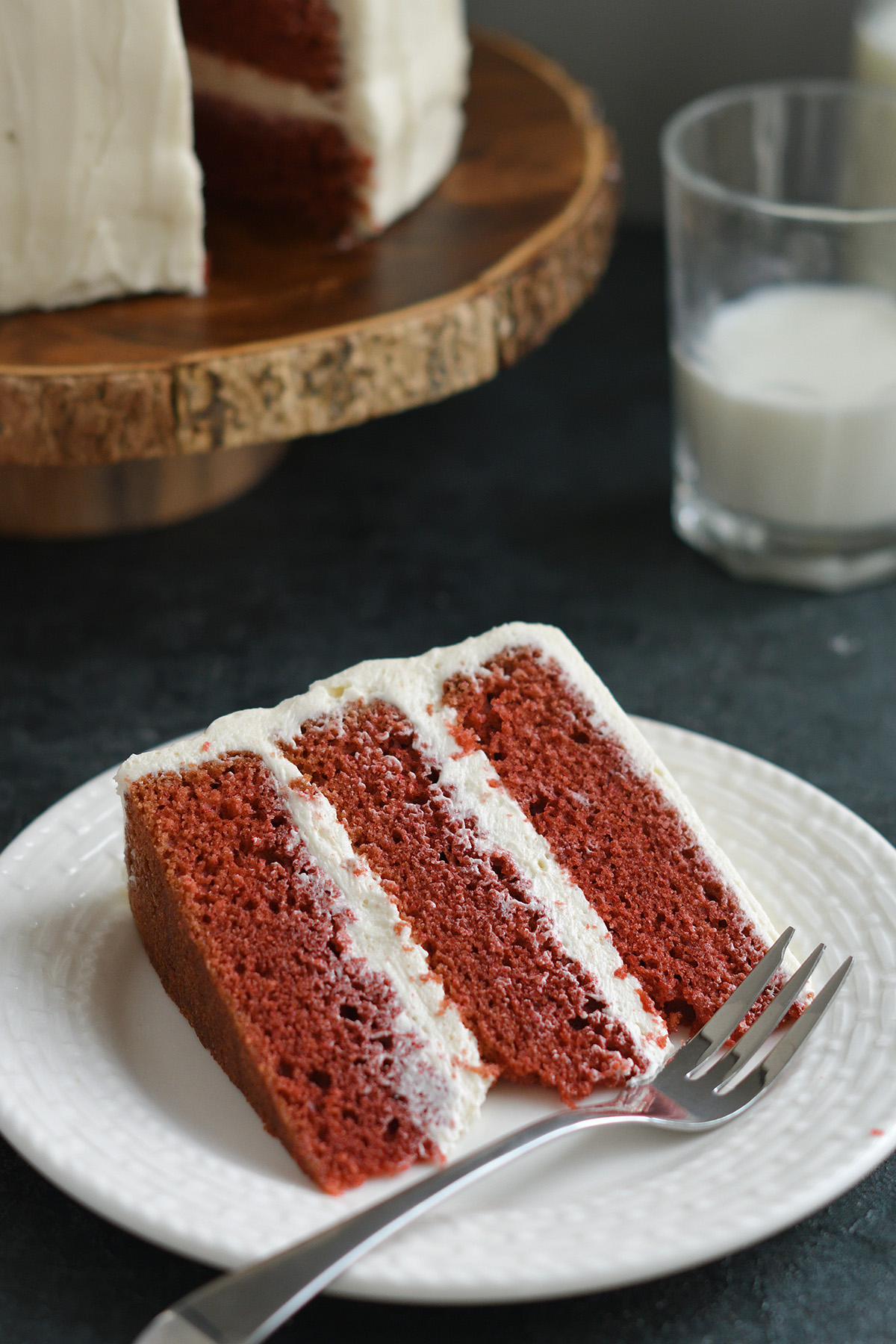
Red Velvet Cake
Ingredients
- 15 oz all purpose flour (3 cups, see note)
- 16 oz granulated sugar (2 cups)
- 1 tablespoon cocoa powder
- 1 ½ teaspoons baking soda
- 1 teaspoon table salt
- 9 oz vegetable oil (1 ¼ cups)
- 8 oz buttermilk (1 cup)
- 3 large eggs (room temperature)
- 1 ½ teaspoons vanilla extract
- 1 ½ teaspoons white vinegar
- red gel food coloring
Instructions
- Preheat the oven to 350 °F. Line three 8” cake pans with parchment paper or butter and flour the bottom of pans only. (See note)
- Over a sheet of parchment paper or into a bowl, sift together 15 oz all purpose flour, 16 oz granulated sugar, 1 tablespoon cocoa powder, 1 ½ teaspoons baking soda and 1 teaspoon table salt. Set aside.
- In a mixer bowl, combine 9 oz vegetable oil, 8 oz buttermilk and 3 large eggs. Mix on medium speed for 2 minutes to emulsify the ingredients. Add 1 ½ teaspoons vanilla extract and 1 ½ teaspoons white vinegar. With the mixer running, add red gel food coloring. If using gel color, use a few drops. If using liquid coloring you may need the whole bottle. Tint to your preferred color.
- Add the sifted dry ingredients to the wet ingredients and mix until completely combined.
- Divide the batter evenly between the pans. Bake until the middle of the cake springs back when lightly pressed, about 30 minutes.
- Cool the cakes in the pans for 10 minutes. Turn the cakes out onto a cooling rack and cool completely before filling and icing. Fill and frost with Ermine Frosting or Cream Cheese Frosting.
Would you like to save this recipe?
As an Amazon Associate and member of other affiliate programs, I earn from qualifying purchases.

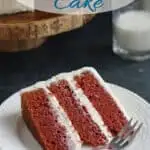
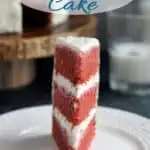
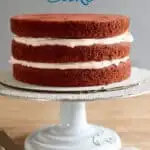
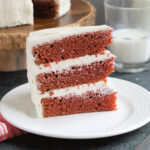





You call for 3 cups of flour, which would weigh 360g not 420g. Which is correct- the cups or the weight?
Both measurements are correct. The weight of a cup of flour is not an absolute. How you fill the cup will determine how much flour is in the cup. I use the “dip and sweep” method for filling the cup. That is, I “dip” the cup into the bin, overfill it, then “sweep” away the excess flour. Using that method I always get 5oz of ap flour per cup. 5oz x 28.3 (gram conversion) = 424g. If you fluff up the flour then lightly spoon it into the cup you can get up to an ounce less per cup. That’s why using weight measurement is always more accurate for baking.
Thanks For Sharing this Amazing Recipe. My Family Loved It. I will be sharing this Recipe with my Friends. Hope They will like it.
Hi I love that so far all your recipes that I have come across, call for Buttermilk as apposed to Yogurt or Sour Cream (which my family & I don’t like)
Question this recipe calls for 1 1/2 tsp. Vinegar. Is that in the Buttermilk mix or extra?
(What I’m getting @ is I make my own Buttermilk using Lemon juice cuz I’m ALERGIC to vinegar . Is the extra vinegar needed & if so, can I use MORE Lemon juice? )
Thanks again!
Buttermilk is one of my FAVORITE baking ingredients. I love the flavor it brings to the batter and the slight acidity is a tenderizer. The vinegar in this recipe is in addition to the buttermilk.
Hello Eileen and THANK YOU for the incredible amount you’re teaching us (read me). I have been wracking my brain to understand the intricacy of cake-baking and, through you, I finally understand so much more!
So before messing up yet another batch (I have dubbed our kitchen the “test kitchen” from all my baking learning curves, hahaha) – am I able to divide this recipe between two 9 inch pans? And what would the baking time be? Thanks in advance 🙂
Hi Summer. You can bake this recipe in two 9″ pans. Since the cakes will be a little thicker the baking time will probably be a bit longer. But remember that baking times are always an estimate and you should always go by what the cake looks like, not the exact time. I would start checking at 25 minutes and look for the center of the cake to spring back when pressed lightly.
Hi Eileen,
How do you prevent or fix the crunchy edge on a round layer cake after baking. Cutting the edge with a knife seems so daunting, but I don’t like to feel that hard edge when eating.
I always use a serrated knife to trim cakes. Just use a slow, steady sawing motion to break the crust and then continue trimming the bits you don’t like. Also, if you refrigerate the cake for a couple of hours after baking, those crusty bits will soften quite a bit.
Hello this cake uses oil but whenever I use oil in my cakes they never bake into a fluffy cake but rather a really stodgy and dense cake with a terrible texture please can you tell me what’s wrong
Have you baked this recipe? Perhaps the recipes you’ve been using aren’t balanced.